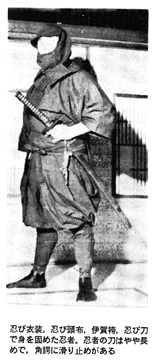
 Fujita Seiko, a prominent Japanese martial artist and researcher of the early 20th century, was born on 13th August, 1899. His original first name was Isamu, but, he chose to change his name to Seiko in his youth, a practice not uncommon in Japanese culture. Fujita is said to have begun his martial arts training early, under the instruction of his grandfather, whom Fujita believed was the 13th soke of the Koga Ryu Wada Ha Ninjutsu system. Fujita claims to have later inherited the art from his grandfather, as the 14th soke of the system.
Fujita Seiko, a prominent Japanese martial artist and researcher of the early 20th century, was born on 13th August, 1899. His original first name was Isamu, but, he chose to change his name to Seiko in his youth, a practice not uncommon in Japanese culture. Fujita is said to have begun his martial arts training early, under the instruction of his grandfather, whom Fujita believed was the 13th soke of the Koga Ryu Wada Ha Ninjutsu system. Fujita claims to have later inherited the art from his grandfather, as the 14th soke of the system.Fujita was a prolific student of the martial arts; in addition to his study of Ninjutsu, he also mastered Nanban Sato Ryu Kenpo, a grappling art; Dai En Ryu Jojutsu, a short staff art; and Shingetsu Ryu Shurikenjutsu, a projectile throwing art. Fujita authored five books relating to various martial arts, served as a body guard to Japan's elite, and practiced the Yamabushi ascetic tradition. Fujita's reputation, however, was most closely associated with his claim to have been 14th soke of the Koga Ryu Wada Ha, which as a Ninjutsu system, would have made Fujita one of the last practitioners of the arcane martial art. During his life, Fujita's claimed association with Ninjutsu added a mystique to his reputation that attracted attention to him and his martial arts. After his death on 4th January 1966, however, his association with Ninjutsu, as seen in the light of the American ninja boom of the 1980's, would call into question his entire life's work, including whether Fujita had even inherited a legitimate Ninjutsu lineage. With the advent of the 1980's American ninja boom associated with Stephen K. Hayes' introduction of the Hatsumi Bujinkan branch of Ninjutsu to the United States, Fujita's reputation became tainted by its unintended association with dubious claimants to the Koga Ninjutsu system. Many of these fraudulent ninja, eager to take advantage of the new martial arts craze's economic potential, claimed that they were the legitimate inheritors of the Koga Ryu. Most of these unscrupulous usurpers were not even sophisticated enough to discover the complete name of Fujita's system. Nevertheless, the association of Fujita's name with these opportunists impacted Fujita's reputation and obscured all of Fujita's accomplishments. Unfortunately the innumerable fraudulent claims led to a dismissive attitude among many martial artists in the west to anything connected with Fujita. This attitude was particularly prevalent among the practitioners of the Hatsumi Bujinkan branch of Ninjutsu, which after Fujita's death, was the last remaining legitimate Ninjutsu lineage accepted by the Bugei Ryuha Daijiten, Japan's official "Martial Arts Directory." In the years following ninja mania in the western world, Hatsumi's students had to constantly compete for exposure with fraudulent Koga ninja. Thus, even two decades later, Fujita's reputation is still seen in this light by many western martial artists. |